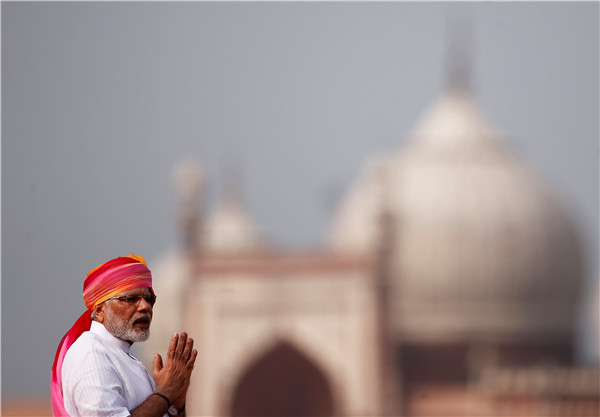India's moves demand strict vigil
 |
|
Indian Prime Minister Narendra Modi gestures as he addresses the nation from the historic Red Fort during Independence Day celebrations in Delhi, India, August 15, 2016. [Photo/Agencies] |
The border situation has been grave for weeks and may take longer to be resolved. China's Ambassador to India Luo Zhaohui said this is the first time Indian troops have crossed the mutually recognized boundary, leading to a close-range face off between Chinese and Indian border troops, which could be potentially explosive even though over the past five decades, not a single bullet has been fired across the India-China border.
Unlike previous face-offs between the two border troops, including the one that lasted 26 days during President Xi Jinping's state visit to India in 2014, the ongoing row is not about bilateral border disputes. India said its troops trespassed on Chinese territory on behalf of Bhutan, which it said has a dispute with China over the Donglong (Doklam in Bhutanese) region.
The truth is, Bhutan was not informed on the day the Indian troops crossed the border, nor did it seek India's intervention. A statement issued by the Bhutanese government on June 29 suggested the country was not consulted by India before the incident and it hoped that status quo would be maintained in the Donglong region. In other words, India is not entitled at all to claim the so-called disputed territory on behalf of Bhutan.
It is also noteworthy that the transgression did not happen in disputed areas, such as those in Depsang and Demchok in the western section of the China-India border before 2008. The Sikkim section has not seen any "trespassing" in the past seven years, because it has long been delimited and both sides have a consensus that Donglong belongs to China.
New Delhi's response is as far-fetched as its "stand up for Bhutan" sophistry. New Delhi claims the Sikkim section of the China-India boundary is not delimited and the two sides only agreed on where the boundary runs, which is a breach of the 1890 Convention and bilateral documents that demarcate the border. China and Bhutan had made it clear years ago that they have no dispute over Donglong. Their failure to ink an agreement has a lot to do with India's meddling.
The China-India border issue will be further complicated if New Delhi presses ahead with the provocations. While visiting the United States two weeks ago, Indian Prime Minister Narendra Modi managed to sell the idea that New Delhi is a key defense partner of Washington and it can serve as a counterweight to China's rise.
A joint statement issued during his US visit said the US-India partnership is "central" to regional stability. In return, US President Donald Trump approved the sale of 22 Predator Guardian drones to India, a "luxury" available only to the US' NATO allies.
It is becoming clear that India is ready to serve as an ally of the US rather than a swing power that honors independent, non-aligned diplomacy. Beijing should remain vigilant against New Delhi's moves while urging it to withdraw its troops from Chinese territory.
The author is a researcher at the Institute of International Studies, Fudan University, Shanghai.
















